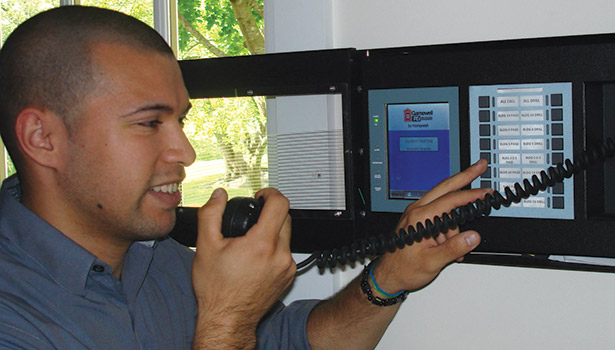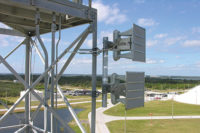Mass notification is a relatively new concept for the life safety community. It arose from the inability of emergency management personnel to communicate with and direct people during emergencies. Since the publication of the Unified Facilities Criteria, a 2002 U.S. Department of Defense program outlining the design, operation, and interfaces required for mass notification in military facilities (the final version for mass notification was approved in 2008), many U.S. military facilities throughout the world have installed mass notification systems (MNS). In the private sector, the demand for MNS has been rising steadily since Sept. 11, 2001. In response, the 2010 edition of NFPA 72 greatly improves design direction for the layout of intelligible voice systems.
The National Fire Protection Association introduced MNS criteria in the annex of the 2007 edition of NFPA 72, where it was presented for explanatory purposes only. After the 2007 edition of NFPA 72 was published, the NFPA Standards Council created a technical committee to develop a new chapter for the 2010 edition. Released in October 2009, the 2010 edition of the National Fire Alarm and Signaling Code provides emergency communication system (ECS) requirements (which include MNS) in Chapter 24. At this time, however, ECS systems are not a requirement of NFPA 72; it provides the design, installation, and maintenance requirements and guidelines for systems if they are required by local codes or other governing authorities or if an owner decides to voluntarily implement an ECS system.
Because the overall purpose of an ECS is to save lives and minimize injuries during emergencies, it is imperative for individuals to clearly understand voice messages delivered over facility-wide communications systems. As a result, the new ECS chapter includes intelligibility requirements for voice systems.
Intelligibility & Acoustically Distinguishable Spaces
What is intelligibility? Speech intelligibility is the measure of the effectiveness of speech. The measurement is usually expressed as a percentage of a message that is understood correctly. The 2010 edition of NFPA 72 defines intelligible (Section 3.3.126) as being capable of being understood, comprehensible and clear; intelligibility (Section 3.3.125) is the quality or condition of being intelligible.
The first step in designing an intelligible voice system is to determine what type of ECS the building owner desires. The voice communication system often will include in-building fire EVACS, in-building mass notification, and a paging system to meet the day-to-day operational objectives. Chapter 24 of the 2010 code permits all three systems to be combined, resulting in an ECS.
Voice intelligibility requirements refer to “acoustically distinguishable spaces” (ADSs). This term, which is new to the 2010 edition of NFPA 72, originated from research conducted by the Fire Protection Research Foundation on how to design and measure intelligibility.
Section 3.3.2 defines an ADS as “distinguished from other spaces due to acoustical, environmental or use characteristics, such as reverberation time and ambient sound pressure level.” An ADS allows the building to be divided into definable spaces so the system designer can identify which spaces in a building may require voice intelligibility.
Not all areas of a building are required to have voice intelligibility. In fact, some building spaces may require only tone signaling, whereas other spaces may require no occupant notification at all. Per Section 24.3.1, an ECS must be capable of reproducing prerecorded or live messages with voice intelligibility in accordance with Chapter 18. Section 18.4.10.1 requires the system designer to identify ADSs during the planning and design of the ECS; and according to Section 18.4.10, each ADS may or may not require voice intelligibility.
In fact, the 2013 edition of the code clarified that not all acoustically distinguishable spaces necessarily have to support voice intelligibility. In Annex A, the list of possibly exempt places includes mechanical rooms, private bathrooms, kitchens, and similar spaces where it would be impractical to achieve intelligibility. Voice evacuation alternatives might be required in these spaces.
Designing an intelligible voice system does not lend itself to prescriptive design as visible notification appliances do. Speech intelligibility is not a physical quantity measured in feet, amperes, volts, or even decibels. It is highly recommended that designers refer to Annex D to plan, design, install, and test voice communication systems.
The majority of the 2010 annex contains recommendations for testing voice system intelligibility. Designers who are new to voice systems may want to consult other sources, such as the National Institute for Certification in Engineering Technologies (NICET) program for Audio Systems or the National Electrical Manufacturers (NEMA) Emergency Communications Audio Intelligibility Applications Guide. Due to the complexity of designing a voice system, it also may be useful to use a software design program to predict voice system intelligibility before installation. These software programs model acoustic properties for specific environments and speaker configurations.
Design Factors to Consider
Several factors to consider when designing a voice system are:
- signal-to-noise ratio,
- frequency response,
- harmonic distortion, and
- reverberation.
Therefore, properly designing an intelligible voice system requires knowledge of the acoustical factors that influence intelligibility, such as the anticipated background noise level, occupancy type, and architectural design of the space. The acoustical properties of the materials on the walls, floors, and ceilings significantly impact the intelligibility of the space. Achieving voice intelligibility may be difficult, or even impossible, depending on the architectural design.
Determine the effects of environmental and acoustical properties when designing a voice system, especially with speaker placement. In the past, fire alarm voice systems typically had too few speakers. It is important for designers to require the right speaker quantity and placement to ensure proper intelligibility and audibility (decibel (dB) rating).
Section 24.4.1.2.2.1 of the 2010 edition requires the following be met for layout and design:
1) The speaker layout of the system shall be designed to ensure intelligibility and audibility.
2) Intelligibility shall first be determined by ensuring that all areas in the building have the required level of audibility.
3) The design shall incorporate speaker placement to provide intelligibility.
A rule of thumb is to install speakers in rooms with 10- to 12-foot ceiling heights at intervals measuring twice the ceiling height and 1 watt per 750 to 1,000 square feet. The ambient noise level of the space served by the speakers must be considered to ensure speakers produce the correct levels of intelligibility and audibility. Ideally, 10–15 dBA above average ambient sound levels provide adequate intelligibility. For the effects of speaker distance and wattage on audibility, see the illustration above.
Avoid installing wall-mounted speakers in large rooms with ceilings up to 15 feet in height; this contributes to reverberation due to longer distances to opposing walls. Also avoid installing speakers on ceilings that are greater than 20 feet in height, especially in rooms with highly reflective walls.
Testing Methodologies
Following installation, the system must be tested for intelligibility. It is important to note that speech intelligibility testing is usually described as predictions, not measurements. Most instrument users, however, refer to the results as measurements. Because portable intelligibility meters are most commonly used for the accurate test results, the results are usually referred to as measurements to avoid confusion.
In accordance with D.2.1.1.1 in the 2010 annex, the recommended method for measuring intelligibility is the Speech Transmission Index (STI) test protocol. STI is a quantitative methodology for measuring intelligibility. In accordance with section D.2.4.1, the intelligibility of an ECS is considered acceptable if at least 90 percent of the measurement locations within each ADS have a measured STI of not less than 0.45 (0.65 CIS) and an average STI of not less than 0.50 STI (0.70 CIS).
Because clearly understanding a live or recorded voice message during an emergency is essential for the safety of a facility’s occupants, planning and testing is crucial. Measuring intelligibility is the best method to ensure clear messages in all situations. n
About the Author: Roopa Shortt is Audible Visible Marketing manager at System Sensor, St. Charles, Ill.
Proper Measures Avoid Having Too Few or Too Many Devices
Measuring intelligibility for fire and emergency communications systems (ECSs) will become more commonplace as local jurisdictions adopt the 2010 and 2013 editions of NFPA 72. Taking proper measures can be complex, and most fire and life safety system designers have to work around existing building features that affect intelligibility.
A lot of what is in the room itself affects intelligibility, such as what’s on the floor and walls, how big the space is, ceiling height and ambient noise conditions.
Speakers are a small part of the overall picture, but system designers can make the most of speaker choices to maximize sound impact. There is a variety of appropriate indoor and outdoor speakers for different applications. For example, some speakers are best for high-fidelity sound output, whereas other speakers are intended to deliver high volume sound output for use in high ambient noise applications.
Fire and life safety system designers can save time and money by installing only as many devices as necessary. To ensure proper coverage without under- or over-designing spaces, system designers can use acoustical simulation software to plan their systems. The software models sound properties for specific environments and speaker configurations. Using the speaker data, intelligibility scores, and variables (such as room materials, ceiling heights and speaker positioning), the software analyzes the information so system designers can make appropriate decisions.
By plugging speaker data into the commercially available simulation software, designers can add or delete speakers and suggest best placement and power tap settings of the speakers. It’s invaluable for users to see how system changes impact the intelligibility score when determining what is best for each application. Once the speakers are installed, system designers can use intelligibility meters to read sound conditions and measure the effectiveness of the voice system at multiple locations within each commercial environment.
These handheld meters can take out the guesswork and demystify intelligibility for building commissioning. During onsite demonstrations, “pink noise” — a type of sound with properties that make it a suitable reference signal for audio engineering — plays throughout the voice system, and the meter predicts the intelligibility score for each location.




